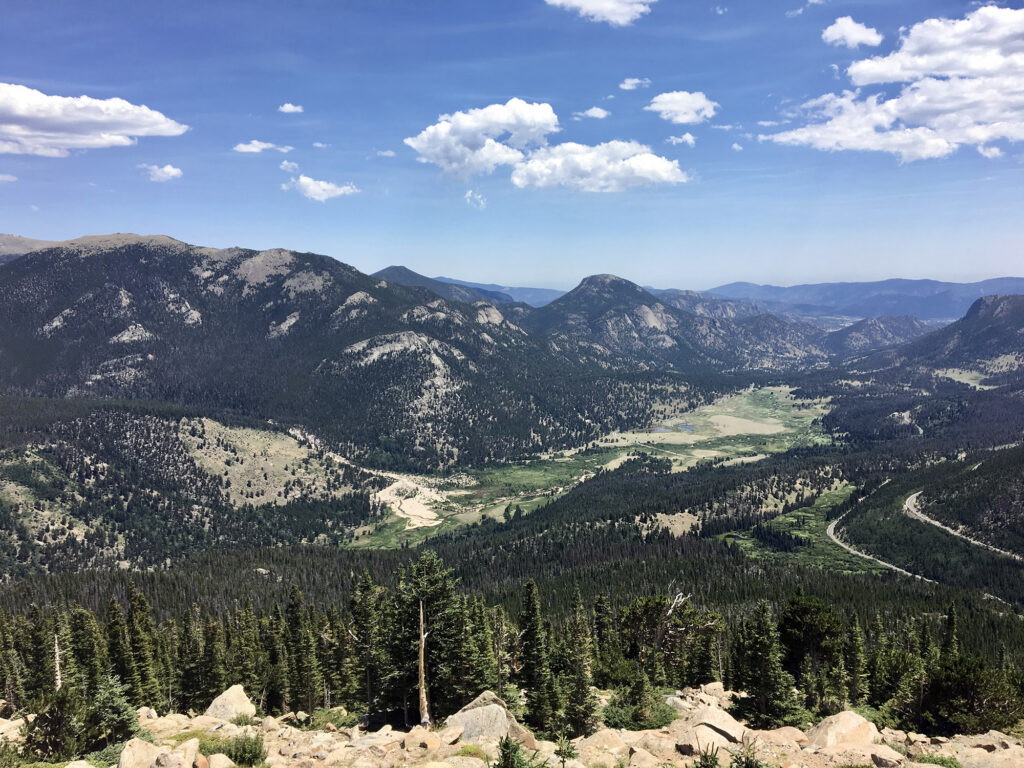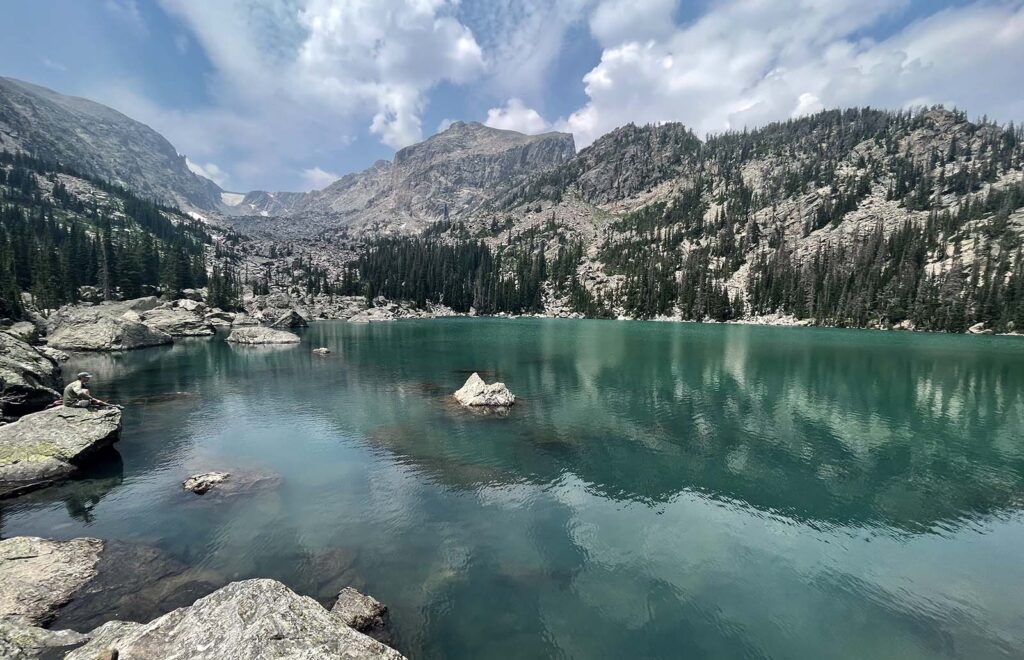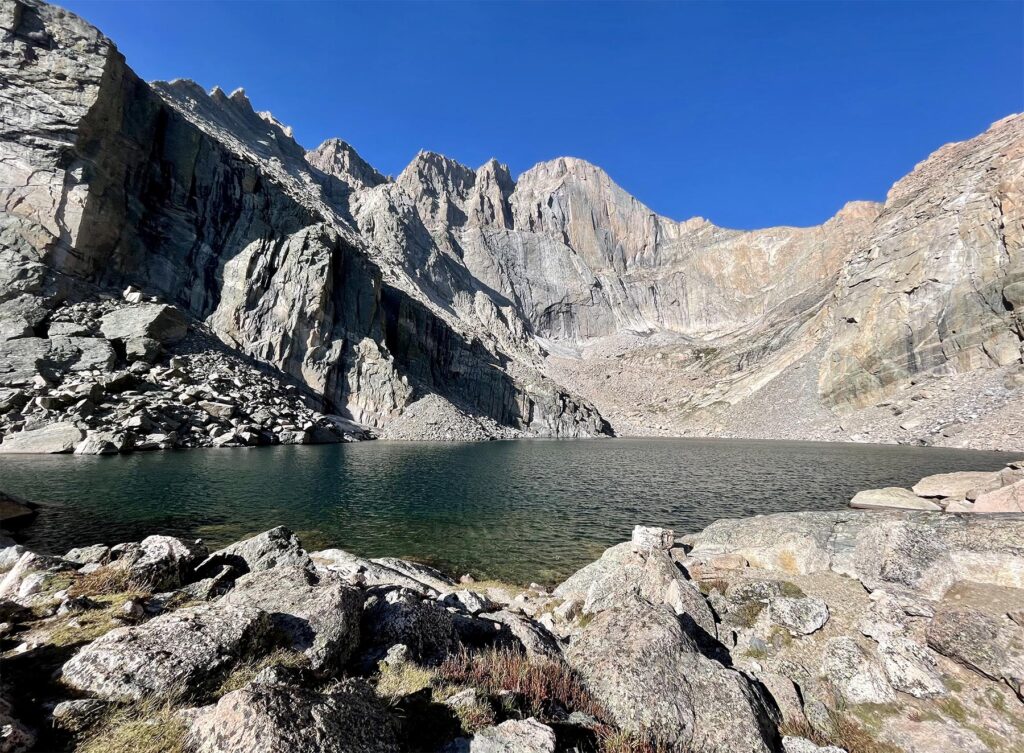Rocky Mountain National Park is a popular destination for all nature lovers and outdoor enthusiasts. Located just 1.5 hours outside of Denver, Colorado, it is pretty easy to get to and has some stunning views of the Rocky Mountains. So it’s no wonder that tons of people flock to the park every year.
If you are traveling to Rocky Mountain National Park, read this guide for some helpful information on the park, popular trails to hike and where to stay.

Getting There
If you are traveling from out-of-state, the closest airport to the park will be Denver International Airport. From Denver, the park is anywhere from a 1.5 hour to 2 hour drive, depending on which entrance you choose to use. The easiest way to get around would be to rent a car from the airport. If you are visiting in any season that’s not Summer, it may be a good idea to rent a AWD or 4WD vehicle.
There are two main sides to the park, East and West, with four entrances. There are three entrances on the East side of the park and one on the West.
East Side Entrances
- Beaver Meadows Entrance: Just West of the town of Estes Park, this is the highest trafficked entrance to the park. This entrance offers easy access to Bear Lake Road and Trail Ridge Road.
- Wild Basin Entrance: This is south of Estes Park, near Allenspark. It offers access to the Wild Basin area of the park.
- Fall River Entrance: This is north of Beaver Meadows and also offers access to Trail Ridge Road and the north end of the park.
West Side Entrance
- Grand Lake Entrance: This is the only entrance to the park on the West side. It is right outside of the town of Grand Lake.
Things to Know
Timed Entry System
The park has implemented a timed entry permit system for the peak season, which is usually around the end of May through the end of October. There are two types of permits:
- One for the Bear Lake Road Corridor, which includes the corridor plus access to the rest of the park. Permits are required for entry from 5 a.m. to 6 p.m.
- One for the rest of the park, excluding the Bear Lake Road corridor. These permits are required for entry from 9 a.m. to 2 p.m. That means that if you are entering the park outside of those times, you will not need a permit.
Permits are released on the first day of the month prior. So for example, if you are trying to visit on July 25, permits for that day will be released on June 1. There are also some permits that are released the day before.
The permits for popular days and times tend to sell out quickly, and the ones for Bear Lake Road Corridor in particular sell out very, very quickly.
Note: You will not need a timed entry reservation if you have a reservation at a park campground.
Parking / Shuttle System
The park offers a shuttle system that is very easy and sometimes necessary, especially during peak season. The main routes are from Estes Park to the Park and Ride on Bear Lake, one from the Park and Ride along Bear Lake Road, and one from the Park and Ride to Moraine Park.
During peak season it can be difficult to find parking at the Bear Lake trailhead and the Glacier Gorge trailhead, especially if you arrive after 9 am. So it may be required to park at the Park and Ride and take the shuttle instead.
Where to Stay
There are many options for lodging near Rocky Mountain National Park, including camping, backpacking, and staying in a hotel or cabin.
Camping
There are five campgrounds in Rocky Mountain National Park that offer a total of over 300 sites:
- Moraine Park Campground: This is on the east side of the park and the largest campground with over 230 sites. It’s also open year-round. Reservations are recommended during peak season and can be made 6 months in advance. Note: This is closed for renovations the summer of 2024.
- Glacier Basin Campground: This is also on the east side of the park located on Bear Lake Rd, so it is a very popular campground. It’s open from late May to early September and has over 150 sites. Reservations are highly recommended during peak season and you can reserve 6 months in advance.
- Aspenglen Campground: This is also on the east side of the park and is open from late May to early September, offering only 26 sites. Reservations are highly recommended during peak season. You can reserve a site 6 months in advance.
- Longs Peak Campground: This is on the east side of the park near the Longs Peak trailhead. It’s very small with only 26 sites, and it’s first-come, first-served. It’s typically open from late June to early September.
- Timber Creek Campground: This is the only campground on the west side of the park. It’s open from late May to early September and has 98 sites. Reservations are required for peak season and can be made 6 months in advance.
Backpacking
Rocky Mountain National Park offers many backcountry camping options and permits are required during the summer. It’s very popular and thus very competitive to get permits. Permits are typically released March 1 for that summer. It’s best to have a plan already established when going to book. You can learn more here.
Hotels and cabins
There are many options for lodging outside the park, including hotels, motels, and cabin rentals. These can mostly be found in the towns of Estes Park, Grand Lake or Denver.
- Estes Park: This small mountain town is located on the east side of the park and offers a wide variety of lodging options, including hotels, motels, bed and breakfasts, and vacation rentals. This town is also home to the Stanley Hotel, the famous, haunted hotel that inspired Stephen King’s “The Shining.”
- Grand Lake: This charming town is located on the west side of the park and also offers a variety of options. It’s a little smaller than Estes Park.
- Denver: This is about a 1.5 – 2 hour drive from the park but can easily be the base for your trip if you are only planning on visiting the park for one day.
Popular Hikes
There are so many beautiful hikes in Rocky Mountain National Park, it’s really hard to choose the best ones to highlight. But I’ve narrowed it down to a few that range from easy to hard.
Easy Hikes
Emerald Lake Trail: This trail certainly packs a lot of beautiful scenery into a short 3.2 miles! You get to see 3 of the park’s most popular lakes and it’s very easy to do, especially if you are coming from sea level and need to catch your breath often. The trailhead is at the end of Bear Lake Road, so you’ll need to get a timed entry permit for the Bear Lake Corridor.
Calypso Cascades: This is another short one at 3.5 miles roundtrip, but also has some beautiful views! This connects to a lot of other trails, so make sure you look out for the signs.
Forest Canyon Overlook: This is less of a hike and more of a short walk out to an overlook point. If you decide to drive the beautiful Trail Ridge Road from one side of the park to the other, make sure you stop here to take in the views!

Moderate Hikes
Lake Haiyaha: This is another trail that starts at the Bear Lake Trailhead. It’s a little longer than Emerald Lake, at 4 miles, and also a little steeper so it’s more of a moderate trail. It ends at a very vibrant teal lake.
Deer Mountain Trail: This is one of the most popular trails in the park as it’s a good length, at 6 miles, and not too steep. It also provides great, sweeping views of the park.
Finch Lake & Pear Lake: This trail is a longer one at 12 miles roundtrip, but it isn’t too steep so it’s still a moderately hard hike. It’s on the south end of the park and takes you deep into it, passing two lakes along the way!

Hard Hikes
Chasm Lake: This is definitely one of my favorites hikes in the park. It’s definitely challenging at almost 9 miles with several areas of a steep climb, but the end view is totally worth it! It ends at Chasm Lake which is shadowed by Longs Peak, one of Colorado’s many 14ers (14,000 ft. mountains).
Longs Peak: Speaking of that 14er…this is another one of the most popular hikes in the park given its elevation, and therefore amazing views, and challenge. It’s definitely a tough one at 13.3 miles roundtrip with many areas of steep climb. This one will also take a long time, typically around 8-9 hours, to complete, so it’s recommended to start very early in the morning. This is especially true for all 14er hikes since the chance for thunderstorms to roll in after 12 pm are pretty high, making it dangerous to be at the top after 12 pm.

